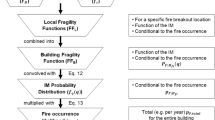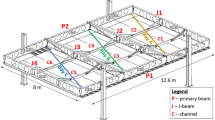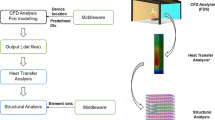Abstract
This paper describes the impact of perimeter column boundary conditions in the modelling of multi-storey structures when subject to fire. An idealised model of a building section is created with a range of column boundary conditions; the sensitivity of results are then analysed. It is found that considering only a limited number of floors results in an overestimation of the moment in the perimeter column by up to 50% under standard heating, but has relatively little impact on beam displacements—less than 5% after standard heating. It is found that the proximity of the boundary conditions has less impact on the results as column stiffness reduces, or if moment connections are provided. A range of possible simplified boundary conditions are considered and it is concluded that the cruder restrained simplifications are likely to lead to an overestimation of column moment sometimes in excess of 50%, but have relatively little impact on floor deflection. Of the idealised boundary conditions analysed, it was found that representing 3 floors and 4 heights of column gives the most significant improvement in accuracy in comparison to a single storey model. Models with pinned boundary conditions ±1-floor (relative to the fire floor) and fixed boundary conditions at ±1.5 or ±2-floors (relative to the fire floor) gave a more accurate result than simply fixing at ±1-floor. It was found that when connections between the beam and the column are pinned, the model with boundary conditions pinned at ±1-floor and fixed at ±2-floors gives a more accurate result than the model with fixed conditions at ±1.5-floors. The results of the study are presented to allow modellers to make an informed judgement about the level of complexity with which to represent a structure above and below the fire-heated floor.









Similar content being viewed by others
References
McAllister TP, Gross JL, Sadek F, Krikpatrick S, MacNeill RA, Zarghamee M, Erbay OO, Sarawit AT (2013) Structural response of World Trade Center buildings 1, 2 and 7 to impact and fire damage. Fire Technol 49(3):709–739. doi:10.1007/s10694-012-0289-2
Usmani A, Röben C, Al-Remal A (2009) A very simple method for assessing tall building safety in major fires. Int J Steel Struct 9(1):17–28
Lange D, Röben C, Usmani A (2012) Tall building collapse mechanisms initiated by fire: mechanisms and design methodology. Eng Struct 36:90–103
Wang YC, Lennon T, Moore DB (1995) The behaviour of steel frames subject to fire. J Constr Steel Res 35(3):291–322
Wang YC (1997) The effects of frame continuity on the behaviour of steel columns under fire conditions and fire resistant design proposals. J Constr Steel Res 41(1):93–111
Bailey CG, Burgess IW, Plank RJ (1996) Computer simulation of a full-scale structural fire test. Struct Eng 74(6):93–100
Bailey CG, Moore DB, Lennon T(1999) The structural behaviour of steel columns during a compartment fire in a multi-storey braced steel-frame. J Constr Steel Res 52(2):137–157
Elghazouli AY, Izzuddin BA (2001) Analytical assessment of the structural performance of composite floors subject to compartment fires. Fire Saf J 36(8):769–793
Gillie M (2000) The behaviour of steel-framed composite structures in fire. University of Edinburgh, Edinburgh
Foster S, Chladná M, Hsieh C, Burgess I, Plank R (2007) Thermal and structural behaviour of a full-scale composite building subject to a severe compartment fire. Fire Saf J 42(3):183–199
Lamont S, Usmani AS, Gillie M (2004) Behaviour of a small composite steel frame structure in a ‘Long-Cool’ and a ‘Short-Hot’ fire. Fire Saf J 39:327–357
Lamont S, Lane B, Flint G, Usmani A (2006) Behavior of structures in fire and real design—a case study. J Fire Prot Eng 16(1):5–35
G. Flint (2005) Fire induced collapse of tall buildings. The University of Edinburgh, Edinburgh
Bailey CG, Burgess IW, Plank RJ (1996) Analyses of the effects of cooling and fire spread on steel-framed buildings. Fire Saf J 26:273–293
Röben C, Gillie M, Torero J, Roben C (2010) Structural behaviour during a vertically travelling fire. J Constr Steel Res 66(2):191–197
Heise A, Flint G, Lane B (2007) Effect of fire on tall buildings: case study. In: Proceedings of 3rd international conference on steel and composite structures
Block FM, Yu C, Butterworth NA (2010) The practical application of structural fire engineering on a retail development in the UK. J Struct Fire Eng 1(4):205–218
Jowsey A, Lim L, Lane B (2009) Structural fire analysis for perimeter braced framed structure. Applications of Structural Fire Engineering, Prague
Kotsovinos P, Law A, Deeny S, Butterworth NA (2014) Structural fire response of tall buidlings with inclined and bi-linear perimeter columns. In: Proceedings of 8th international conference on structures in fire, pp 1031–1038
Garlock MM, Quiel SE (2007) The behavior of steel perimeter columns in a high-rise building under fire. AISC Eng J 44(4):359–372
Quiel SE, Garlock MEMM (2008) A closed-form analysis of perimeter member behaviour in a steel building frame subject to fire. Eng Struct 30(11):3276–3284
COST TU0904 (2012) Integrated fire engineering and response: case studies. In: F Wald, I Burgess, G Rein, L Kwasniewski, P Vila Real, K Horova (eds) CTU Publishing Production, Czech Technical University, Prague
Wang YC, Lennon T, Moore DB (1995) The behaviour of steel frames subject to fire. J. Constr. Steel Res 35(3):291–322
EN1993-1-1 (2010) Eurocode 3: design of steel structures—Part 1-1: general rules and rules for buildings
EN1994-1-1 (2008) Eurocode 4: design of composite steel and structures—Part 1-1: general—structural fire design
EN1990 (2004) Eurocode 0: basis of structural design
EN1991-1-1 (2009) Eurocode 1: actions on structures—Part 1-1: general actions—densities, self-weight and imposed loads
EN1993-1-2 (2005) Eurocode 3: design of steel structures—Part 1-2: general rules—structural fire design
FIB Model Code for Concrete Structures (2013) Special Activity Group 5: New Model Code, Ernst & Sohn, Berlin
Huang Z, Burgess IW, Plank RJ (1999) The influence of shear connectors on the behaviour of composite steel-framed buildings in fire. J Constr Steel Res 51(3):219–237
LS-DYNA (2012) Keyword user’s manual, vol I (version 971 R6.1.0). Livermore Software Technology Corporation, Livermore
Gillie M (2009) Analysis of heated structures: nature and modelling benchmarks. Fire Saf J 44(5):673–680
ISO 834-1 (1999) Fire-resistance tests—elements of building construction—Part 1 general requirements. International Organization for Standardization, London
Flint G, Lamont S, Lane B, Sarrazin H, Lim L, Rini D, Roben C (2013) Recent lessons learned in structural fire engineering for composite steel structures. Fire Technol 49(3):767–792. doi:10.1007/s10694-012-0291-8
Author information
Authors and Affiliations
Corresponding author
Rights and permissions
About this article
Cite this article
Law, A. Perimeter Column Boundary Conditions in Structural Fire Modelling. Fire Technol 52, 1845–1861 (2016). https://doi.org/10.1007/s10694-015-0530-x
Received:
Accepted:
Published:
Issue Date:
DOI: https://doi.org/10.1007/s10694-015-0530-x




